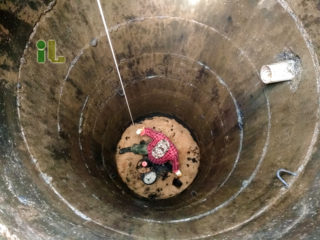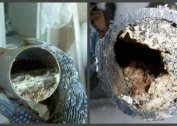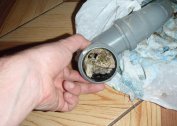A cesspool is commonly used for wastewater disposal in suburban areas. But owners often have the problem of quickly filling it. Already literally after a year of use, the owner notices that the water does not leave the pit, even with regular calls of sewage trucks. There are several ways to solve the problem.
The root causes of the problem
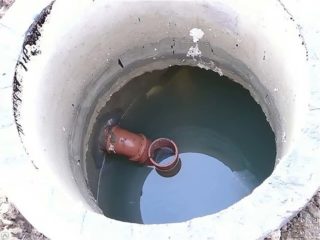 A cesspool is a receiver formed directly in the soil. Typically, for the drainage of water, a bottom is made of crushed stone of fine fraction, sand and broken brick in it. In some cases, the bottom and walls are left unpaved. The essence of this system is that runoff is gradually absorbed into the soil through the walls and bottom. However, over time, the water absorption capacity of the reservoir decreases for the following reasons:
A cesspool is a receiver formed directly in the soil. Typically, for the drainage of water, a bottom is made of crushed stone of fine fraction, sand and broken brick in it. In some cases, the bottom and walls are left unpaved. The essence of this system is that runoff is gradually absorbed into the soil through the walls and bottom. However, over time, the water absorption capacity of the reservoir decreases for the following reasons:
- Siltation - deposition at the bottom of fecal sludge. It forms a crust that prevents the fluid from going into the ground.
- Fatty plaque - occurs due to the discharge of food residues into the sewer system and washing dishes. Such a film also prevents water from seeping into the soil.
- Freezing soil - if the cesspool has ceased to fulfill its functions in the cold, most likely the system simply froze.
- The receiver is not large enough - perhaps the number of drains does not correspond to the volume of the cesspool due to the increase in the number
- residents and connecting additional household appliances.
Methods to Eliminate Bad Outflow
Fecal matter and insoluble fat, falling into the sewer system, settle on the bottom of the drive. Gradually, these deposits form a crust, which prevents the natural outflow of water. In addition, fat deposits and soap film clog the pores of the soil, which is also not the best way affects the system. There are several ways to solve the problem.
Mechanical cleaning
The mechanical method involves the following sequence of actions:
- First you need to call the scavengers and pump out the contents of the cesspool.
- The sludge remaining on the bottom and walls is gradually washed off with warm water and scraped off with brushes. To soften organic compounds, you can use biological products.
- After cleaning the surfaces, the pit is filled with water and pumped out again.
- Additionally, the entire piping system is flushed. Fatty deposits also accumulate in it.
- The pit must be dried, after which it can again be used.
The use of bacteria
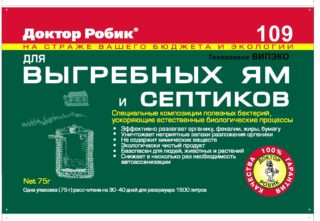 The use of bacteria for the cesspool reduces the rate of formation of solid sediment. Such preparations are very easy to use - the contents of the package are simply poured into the tank, acting according to the attached instructions, and ensure a regular flow of wastewater. At the same time, during the cleansing of the pit, all sludge cannot be removed, because this is food for bacteria.
The use of bacteria for the cesspool reduces the rate of formation of solid sediment. Such preparations are very easy to use - the contents of the package are simply poured into the tank, acting according to the attached instructions, and ensure a regular flow of wastewater. At the same time, during the cleansing of the pit, all sludge cannot be removed, because this is food for bacteria.
The use of biological products has the following advantages:
- cleaning the walls of the sewer;
- liquefaction of the solid component of effluents;
- fat decomposition;
- restoration of soil porosity;
- elimination of unpleasant odor;
- preventing the formation of sludge on the walls and bottom of the drive.
Preparations with live microorganisms may differ in their functions, therefore, before use, you should familiarize yourself with the spectrum of action, based on what result you want to get.
Important! To ensure the effective operation of the biological product, it is necessary to strictly follow the instructions for use.
Use of chemicals
With poor outflow of wastewater from the cesspool, chemicals are also used.The main active components here are formaldehydes, nitrate oxidizing agents and ammonium compounds. All of them help to clean the walls of the sewer system from sludge and fat.
But there are some nuances that are important to know before using chemicals:
- Formaldehydes are very harmful to the soil. They make her dead for 7 to 10 subsequent years. That is, not a single plant can grow around the sewage pit. Formaldehyde-based products are recommended by experts less frequently.
- If the main active substance is ammonium, then such funds will be effective only at temperatures above zero. However, their advantage is that they eliminate unpleasant odors and dissolve deposits inside the tank.
- The most gentle means are based on nitrate oxidizing agents. Sludge dissolved with the help of these substances can be used to fertilize the garden.
Attention! When working with chemicals, the rules of TB should be followed, i.e. wear a respiratory mask and gloves.
Defrosting pits at subzero temperatures
Typically, when installing a cesspool, measures are thought out to protect it from the cold: it should be below the freezing point, a lid insulated with mineral wool or foam should be provided on top. If for some reason these conditions were not met, the pit may freeze. In this case, the following methods of resuscitation will help:
- Hot water is poured into the system through the sewer hole, then the tank is insulated from above.
- The most optimal way is to use a self-heating cable. If the pit is frozen, you can buy a piece of this cable and lower it into the receiver for a while. The cable automatically disconnects when the set ambient temperature is reached.
What can be done if the pit volume is less than necessary
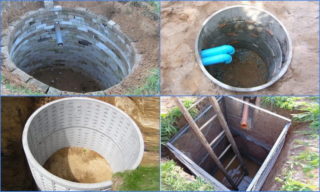 In this case, it is necessary to increase the volume of the cesspool. A simple solution is to dig another receiver nearby and connect it to the old overflow pipe. The bottom of the first is better concreted. In the second pit, the bottom should be equipped with a drainage system.
In this case, it is necessary to increase the volume of the cesspool. A simple solution is to dig another receiver nearby and connect it to the old overflow pipe. The bottom of the first is better concreted. In the second pit, the bottom should be equipped with a drainage system.
As a result of such alteration, a real septic tank is obtained, which almost does not harm the environment. The level of wastewater treatment in it is about 65-70%.
Prevention of the problem
Everyone knows that it is better to prevent the development of a problem than to spend time and money on fixing it. Observing simple operating rules, you can achieve smooth operation of the system:
- Flush the pit under high pressure 6-8 times a year.
- Once a year, pump out the contents of the receiver.
- Use biological or chemical anti-silica agents regularly.
- Design and arrange good thermal insulation to reduce the risk of freezing of the system. To prevent freezing in sub-zero temperatures, pre-install a heat-insulating layer or systematically warm the tank and pipes.
To prevent siltation of the sewage pit and the formation of a greasy film, grease traps should be installed on all sinks and household appliances. They significantly extend the life of the entire system.
An ideal option is to install a septic tank between the house and the drainage pit. With this arrangement of the system, wastewater is purified by 70-95% and goes into the ground without harming the environment.
Compliance with preventive measures and the regular use of bio-and chemical products will allow the sewer system to work without interruption for many years. In addition, it is recommended to systematically clean the pit from drains.
